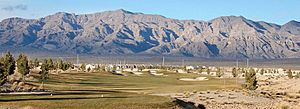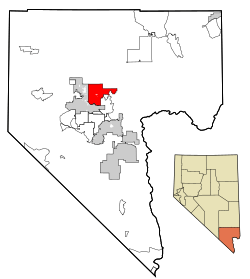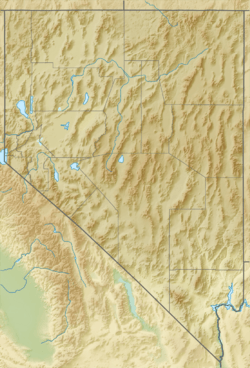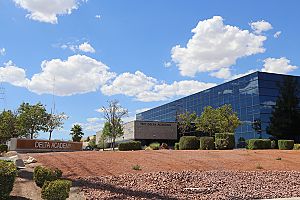North Las Vegas, Nevada facts for kids
Quick facts for kids
North Las Vegas, Nevada
|
||
|---|---|---|

North Las Vegas and the surrounding Las Vegas Range
|
||
|
||
| Nicknames:
North Town
|
||
| Motto(s):
Your Community of Choice
|
||

Location within Clark County
|
||
| Country | ||
| State | ||
| County | Clark | |
| Founded | 1919 | |
| Incorporated | May 1, 1946 | |
| Government | ||
| • Type | Council–manager | |
| Area | ||
| • Total | 102.37 sq mi (265.13 km2) | |
| • Land | 102.32 sq mi (265.02 km2) | |
| • Water | 0.04 sq mi (0.11 km2) | |
| Elevation | 2,205 ft (672 m) | |
| Population
(2020)
|
||
| • Total | 262,527 | |
| • Density | 2,565.64/sq mi (990.60/km2) | |
| Time zone | UTC−8 (PST) | |
| • Summer (DST) | UTC−7 (PDT) | |
| ZIP codes |
89030–89033, 89036, 89081, 89084–89087
|
|
| Area code(s) | 702 and 725 | |
| FIPS code | 32-51800 | |
| GNIS feature ID | 0847435 | |
North Las Vegas is a suburban city in Clark County, Nevada, United States, in the Las Vegas Valley. As of the 2020 census it had a population of 262,527, with an estimated population of 280,543 in 2022. The city was incorporated on May 1, 1946. It is the 3rd most populous city in the state of Nevada, and the 75th most populous city in the United States.
Contents
History
Native Americans were the first to inhabit the area. Paiute Indians settled in the area in around 700AD.
During the 1860s, Conrad Kiel established a ranch at the modern-day intersection of Carey Street and Losee Road in what would be North Las Vegas. In 1917, libertarian Thomas L. Williams of Eureka, Utah visited the Las Vegas Valley, back when Las Vegas, Las Vegas Indian Colony, and Arden were the only entities in the valley. He did not approve of Las Vegas, perhaps because of its rowdiness (he was a Christian, or at least went to church), or because Las Vegas' attempts at municipal control over its citizens. However, he was pleased by the abundance of the valley's artesian water and potential for agriculture. Two years later in 1919, he moved together with his family (his wife and three sons) to a 160-acre piece of land a mile from Las Vegas. That year, he founded his town, developing the town by building for himself and his family a house, sinking a well, grading roads, extending power lines, and forming a system of irrigation ditches. Williams believed that churches and church people should govern the new town, and so encouraged churches to buy property in the town. In 1919, the federally enforced Volstead Act was passed, which prohibited the sale, possession, and consumption of alcohol. Since there was no local law against alcohol, and because of a system of tunnels that would connect the town's underground speakeasies, the town attracted bootleggers from Las Vegas, although Williams was initially unaware of this. This gave his town the nickname of "Old Town". When he did discover it, he stuck with agriculture for his economic purposes.
In 1924, Williams built his second house that was the first business of the town. It was named the Oasis Auto Court, and it contained a grocery store, a campground, a post office, a community center, and a telephone. At the time, it was the town's only telephone. Between 1928 and 1935, a large influx of workers from the Hoover Dam settled in Williams' town, as Las Vegas was intolerant towards them. In 1932, the town board was created. That same year, the town's first grammar school, Washington School, opened. A proper name had not yet been established for the town, and Williams did not want it named after himself, which lead to the town board voting for either "North Las Vegas" or "Vegas Verdes" (which means "Green Meadows" in Spanish). "Vegas Verdes" won, and that became the name for the town for a few months. George Hansen, a town board member who voted for the name "North Las Vegas", noticed that at one town board meeting, two members who voted the name "Vegas Verdes" were absent. The vote for a name came once again, and "North Las Vegas" won. In 1939, Williams died of stroke, and that left North Las Vegas to the ruling of the town board. An elementary school, and a road, were eventually named after him. During World War II, the Las Vegas Aerial Gunnery School opened in North Las Vegas. It would eventually become Nellis Air Force Base. North Las Vegas was the subject of many annexation attempts from Las Vegas. On May 1, 1946, North Las Vegas was incorporated as a city. In 1957, North Las Vegas planned to annex an area to its southeast, and in response, the Clark County Commission created the town of Sunrise Manor to prevent further annexation attempts.
On May 13, 1964, First Lieutenant Raynor Lee Hebert, a student pilot from Port Arthur, Texas, took off from Nellis Air Force Base at approximately 2:00 PM on an F-105 fighter jet. He radioed his flight leader saying that he could not retract his nose gear, and thus could not gain altitude. He was at a height high enough to bail out, but too low that if he did, he would've hit Lincoln Elementary School, which was in session with 800 students. He kept the plane nose up long enough to pass the school, and eventually hit nine residential houses on Lenwood Avenue. The crash killed Hebert and four civilians. Hebert Memorial Park was created by the City of North Las Vegas with a plaque at the crash site to commemorate Hebert.
In the early 1960s, North Las Vegas had a major growth boom. The 1970s in North Las Vegas saw a growth in poor neighborhoods, population density, and crime.
In the 1990s, North Las Vegas annexed about 60 square miles (160 km2) of empty desert surrounding the city, reportedly for more "upscale" housing.
Geography
Located within the Mojave Desert in the southwestern United States, North Las Vegas sits northeast of Las Vegas. According to the United States Census Bureau, North Las Vegas has a total area of 101.4 square miles (262.6 km2), of which 0.04 square miles (0.1 km2), or 0.04%, is water. In the Las Vegas Valley, there are several prominent mountain ranges nearby.
Climate
Due to its location within the Mojave Desert, North Las Vegas has a desert climate. Temperatures are generally mild in the winter and hot in the summer. Like most of the hot deserts of the United States, snowfall only occurs once every few years on average. In winter, temperatures rarely fall below freezing. In the summer, monsoons can reach the area, bringing heavy rain and thunderstorms.
| Climate data for North Las Vegas, Nevada | |||||||||||||
|---|---|---|---|---|---|---|---|---|---|---|---|---|---|
| Month | Jan | Feb | Mar | Apr | May | Jun | Jul | Aug | Sep | Oct | Nov | Dec | Year |
| Record high °F (°C) | 80 (27) |
86 (30) |
93 (34) |
100 (38) |
112 (44) |
117 (47) |
119 (48) |
115 (46) |
116 (47) |
101 (38) |
88 (31) |
77 (25) |
119 (48) |
| Mean daily maximum °F (°C) | 58 (14) |
64 (18) |
71 (22) |
80 (27) |
89 (32) |
100 (38) |
105 (41) |
103 (39) |
95 (35) |
83 (28) |
68 (20) |
59 (15) |
81 (27) |
| Mean daily minimum °F (°C) | 30 (−1) |
35 (2) |
40 (4) |
47 (8) |
56 (13) |
64 (18) |
71 (22) |
69 (21) |
61 (16) |
49 (9) |
37 (3) |
30 (−1) |
49 (9) |
| Record low °F (°C) | 10 (−12) |
16 (−9) |
21 (−6) |
31 (−1) |
41 (5) |
48 (9) |
59 (15) |
54 (12) |
45 (7) |
25 (−4) |
17 (−8) |
11 (−12) |
10 (−12) |
| Average precipitation inches (mm) | 0.64 (16) |
0.68 (17) |
0.65 (17) |
0.21 (5.3) |
0.26 (6.6) |
0.08 (2.0) |
0.30 (7.6) |
0.49 (12) |
0.27 (6.9) |
0.29 (7.4) |
0.33 (8.4) |
0.38 (9.7) |
4.58 (116) |
Demographics
| Historical population | |||
|---|---|---|---|
| Census | Pop. | %± | |
| 1940 | 3,875 | — | |
| 1950 | 3,875 | 0.0% | |
| 1960 | 18,422 | 375.4% | |
| 1970 | 36,216 | 96.6% | |
| 1980 | 42,739 | 18.0% | |
| 1990 | 47,707 | 11.6% | |
| 2000 | 115,488 | 142.1% | |
| 2010 | 216,961 | 87.9% | |
| 2020 | 262,527 | 21.0% | |
| U.S. Decennial Census | |||
2020 census
| Race / Ethnicity (NH = Non-Hispanic) | Pop 2000 | Pop 2010 | Pop 2020 | % 2000 | % 2010 | % 2020 |
|---|---|---|---|---|---|---|
| White alone (NH) | 42,880 | 67,687 | 64,187 | 37.13% | 31.20% | 24.45% |
| Black or African American alone (NH) | 21,528 | 41,561 | 56,049 | 18.64% | 19.16% | 21.35% |
| Native American or Alaska Native alone (NH) | 565 | 871 | 807 | 0.49% | 0.40% | 0.31% |
| Asian alone (NH) | 3,604 | 13,122 | 16,861 | 3.12% | 6.05% | 6.42% |
| Pacific Islander alone (NH) | 547 | 1,684 | 2,550 | 0.47% | 0.78% | 0.97% |
| Other race alone (NH) | 143 | 377 | 1,437 | 0.12% | 0.17% | 0.55% |
| Mixed race or Multiracial (NH) | 2,786 | 7,525 | 13,696 | 2.41% | 3.47% | 5.22% |
| Hispanic or Latino (any race) | 43,435 | 84,134 | 106,940 | 37.61% | 38.78% | 40.73% |
| Total | 115,488 | 216,961 | 262,527 | 100.00% | 100.00% | 100.00% |
2010 US census
At the census of 2010, there were 216,961 people residing in North Las Vegas. The racial makeup was 47.4% White, 19.9% African American, 0.8% Native American, 6.3% Asian, 0.8% Pacific Islander, and 5.8% from two or more races. Hispanic or Latino residents of any race were 38.8% of the population, and 31.2% of the population was non-Hispanic White.
2000 US census
As of the 2000 census, there were 115,488 people, 34,018 households, and 27,112 families residing in the city. The population density was 1,471.0 inhabitants per square mile (568.0/km2). There were 36,600 housing units at an average density of 466.2 per square mile (180.0/km2). The racial makeup of the city was 55.93% White, 19.02% African American, 0.82% Native American, 3.24% Asian, 0.53% Pacific Islander, 15.78% from other races, and 4.68% from two or more races. 37.61% were Hispanic or Latino of any race.
There were 34,018 households, out of which 47.8% had children under the age of 18 living with them, 57.3% were married couples living together, 15.2% had a female householder with no husband present, and 20.3% were non-families. 13.6% of all households were made up of individuals, and 3.2% had someone living alone who was 65 years of age or older. The average household size was 3.36 and the average family size was 3.67.
In the city the population was spread out, with 33.9% under the age of 18, 9.6% from 18 to 24, 34.3% from 25 to 44, 16.4% from 45 to 64, and 5.8% who were 65 years of age or older. The median age was 29 years. For every 100 females, there were 104.3 males. For every 100 females age 18 and over, there were 103.1 males.
The median income for a household in the city was $46,057, and the median income for a family was $46,540. Males had a median income of $32,205 versus $25,836 for females. About 11.8% of families and 14.8% of the population were below the poverty line, including 19.6% of those under age 18 and 8.8% of those age 65 or over. The United States Census Bureau listed North Las Vegas, as well as the Las Vegas metropolitan area, as one of the fastest-growing regions in the United States.
Economy
Bigelow Aerospace is headquartered in North Las Vegas. Traditionally, manufacturing, industrial and warehouse distribution companies have dominated the local market. High-tech businesses, including solar and green technology, and custom manufacturing facilities are moving to North Las Vegas.
On May 12, 2019, Amazon opened a 850,000-square-foot fulfillment center in North Las Vegas which currently employs more than 1,500 people. In October 2019 Sephora opened a 715,000-square-foot distribution center in North Las Vegas.
As construction began on the nearby Brightline West highspeed railroad project, PCM Railone AG announced in June 2024 that they would build a production facility for concrete ties and open a North American headquarters in North Las Vegas.
Florence McClure Women's Correctional Center, Nevada's only female correctional facility, is located in North Las Vegas.
.....
Master-planned communities in the city include Aliante and Eldorado. The Apex industrial Park is now a part of the city as well.
Education
North Las Vegas is home to the Cheyenne Campus of the College of Southern Nevada. The institution covers an area of roughly 80 acres (32 ha) and provides for a broad variety of different courses. As of 2013, the University of Nevada, Las Vegas was planning to open a branch in North Las Vegas near the I-215 Beltway, though this plan has yet to be implemented as of 2022.
Primary and secondary school students in North Las Vegas are served by the Clark County School District (CCSD), the fifth-largest in the United States with over 300,000 students enrolled in any of its 357 schools. CCSD has a workforce of over 35,000 people, and is considered a major employer in the county.
The following high schools are in North Las Vegas:
- Canyon Springs
- Cheyenne
- Legacy
- Mojave
- Rancho
Transportation
North Las Vegas Airport, formerly known as Sky Haven Airport, was established on December 7, 1941. A division of Vision Airlines operates tours to the Grand Canyon in Arizona from the airport.
RTC Transit provides bus service in the city, as it does throughout the Las Vegas metropolitan area.
See also
 In Spanish: North Las Vegas para niños
In Spanish: North Las Vegas para niños






